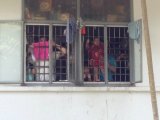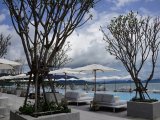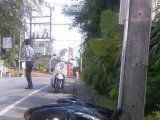BANGKOK: They no longer fly the skull and crossbones flag, instead clambering aboard ships wielding guns and knives under the cover of darkness.
''They put knives on our throats and threatened to kill us if we resisted,'' said Pham Van Hoang, deputy captain of the 4000-tonne Vietnamese-registered ship MT Sunrise 689, which went missing for a week with a crew of 18 after leaving Singapore on October 2.
Modern piracy is surging in the waters of South-east Asia, including the Malacca Strait, a bottleneck for 50,000 ships a year carrying more than a third of the world's shipping trade.
The attack on the MT Sunrise loaded with 5200 tonnes of oil was the twelth ship hijacking in the region since April.
There were 129 reported cases of piracy and armed robbery against ships in Asia from January to September, the highest number in at least eight years, according to ReCAAP, a 20-country organisation set up to combat piracy and armed robbery in Asia.
Many other incidents are unreported, anti-piracy experts say, because some shippers want to avoid their names being associated with lax security or lost cargoes.
Half of the world's ship attacks now take place in strategic waters off Indonesia, Singapore and Malaysia, a region that accounts for the transportation of almost all crude oil that east Asia imports from the Middle East, experts say.
Highly organised criminal gangs have rewritten the textbook on a new form of piracy plaguing the waterways: stealing cargoes of liquid fuel, sometimes using their own tankers to carry the stolen product to prearranged buyers.
Multinational organisations that combat piracy say the modus operandi in the hijackings is almost always the same with the pirates often having obtained prior knowledge of the ship's route and cargo.
Pirates in two wooden boats were forced to abandon their first attempt to hijack the 3758 tonne Honduras-registered Ai Maru in the South China Sea in 2012 when a light plane happened to fly overhead.
But as the ship steamed alone about 50 kilometres off the coast of Malaysia on the night of June 14 seven men with pistols climbed aboard from speed boats, smashed through doors, tied up 13 crew members at gunpoint, stole their personal belongings and disabled the ship's communications equipment.
A second unidentified tanker piloted by more pirates pulled alongside. The robbers siphoned 620 metric tonnes of marine gas oil to their own ship.
When six vessels from the Royal Malaysian Navy, the Malaysian Maritime Enforcement Agency and the Indonesian Navy arrived at the Ai Maru hours later the ship was dead in the water, the pirates long gone with their booty worth about $550,000 on the black market.
While the Oscar-nominated film 'Captain Phillips' focused on an attack by Somali pirates on the Maersk Alabama in 2009, criminals operating off Africa have been largely put out of business.
''The Horn of Africa is slowing down because the cop is on the beat there,'' Richard Phillips, the real-life ex-captain of the Maersk-Alabama told the US television network CNBC.
''But Indonesia is a target-rich environment, with lots of vessels. And there's definitely co-operation from onshore that helps these pirates who are out there,'' he said.
Unlike the trigger-happy kidnap-for-ransom Somali gangs, the pirates operating in south-east Asia prefer to make money by stealing what they can sell, rather than ransoming hostages.
The hijacking of the MT Sunrise while en route from Singapore to the Vietnamese port of Quang Tri raised concerns about how a ship built just two years ago could simply vanish for seven days in one of the world's busiest areas for shipping?
Shipping authorities and the region's militaries had no idea where MT Sunrise was after it disappeared from radar shortly after steaming from Singapore, until pirates thought to be Indonesian abandoned the ship on October 10 about 150 kilometres off Vietnam's southern coast.
Often pirates calculate that their target ship will not be noticed among hundreds of others in the area, and sometimes paint new names on vessels.
There have been at least four attacks in broad daylight in the waters of the Singapore Strait this year.
Calls are growing for stepped-up naval efforts to stamp out hijackings.
''Demand for fuel/oil remains high and pirates/robbers are likely to continue with this lucrative business unless governments and the shipping industry can work together collectively to arrest the perpetuators to serve as a deterrent,'' ReCAAP warned.
Following the MT Sunrise hijacking, which left several crew members injured, Vietnam called on countries both inside and outside the region to co-operate more closely.
The International Maritime Bureau has also called on regional authorities to step up co-operation on global piracy that experts estimate costs shippers more than $4 billion a year in the form of lost cargo, higher insurance, added shipping times, crew compensation, litigation and legal fees.
As well as attacks on ships at sea, criminals are selecting ships at port or anchorage, and tugs and barges, statistics show.
Of 150 reported attacks in Asia last year, 110 involved ships at anchor and at berth, including for petty thefts.
The luxurious yacht of Australian businessman Kerry Stokes was boarded and robbed by pirates early in October off the east coast of Papua New Guinea. Mr Stokes was not aboard at the time.
Sam Bateman, a former Australian navy commodore and adviser to the Maritime Security Program at Singapore's S. Rajaratnam School of International Studies, warned recently that small product tankers of about 1000 tonnes are particularly vulnerable to attack in regional waters because of their size, relatively slow speed and low distance from waterline to upper deck when laden. He said some ships are not compliant with international security code.
But Mr Bateman said the region's piracy and sea robbery should be kept in perspective.
''Most ships transiting regional waters are not at risk unless they slow down or anchor in areas where attacks occur,'' he said.
''Major requirements to reduce the number of attacks in the region include better security in ports and anchorages and effective inter-agency coordination both at sea and onshore.''
Experts say it will be difficult to shut down organised criminal syndicates behind many of the attacks that use skulduggery to gather intelligence from corrupt seafarers, port workers or government or military sources.
About 1am on April 22 two vessels came alongside the 2991-tonne St Kitts and Nevis-registered MT Naniwa Maru 1 about 45 kilometres off the Malaysian coast.
Five men climbed aboard before 2200 metric tonnes of diesel oil was siphoned off over the next few hours.
The ship's chief officer and chief engineer were initially thought to have been kidnapped but according to ReCAAP, local authorities discovered they actually scarpered with the robbers, apparently promised a cut of the ill-gotten proceeds.
Fairfax Media
''They put knives on our throats and threatened to kill us if we resisted,'' said Pham Van Hoang, deputy captain of the 4000-tonne Vietnamese-registered ship MT Sunrise 689, which went missing for a week with a crew of 18 after leaving Singapore on October 2.
Modern piracy is surging in the waters of South-east Asia, including the Malacca Strait, a bottleneck for 50,000 ships a year carrying more than a third of the world's shipping trade.
The attack on the MT Sunrise loaded with 5200 tonnes of oil was the twelth ship hijacking in the region since April.
There were 129 reported cases of piracy and armed robbery against ships in Asia from January to September, the highest number in at least eight years, according to ReCAAP, a 20-country organisation set up to combat piracy and armed robbery in Asia.
Many other incidents are unreported, anti-piracy experts say, because some shippers want to avoid their names being associated with lax security or lost cargoes.
Half of the world's ship attacks now take place in strategic waters off Indonesia, Singapore and Malaysia, a region that accounts for the transportation of almost all crude oil that east Asia imports from the Middle East, experts say.
Highly organised criminal gangs have rewritten the textbook on a new form of piracy plaguing the waterways: stealing cargoes of liquid fuel, sometimes using their own tankers to carry the stolen product to prearranged buyers.
Multinational organisations that combat piracy say the modus operandi in the hijackings is almost always the same with the pirates often having obtained prior knowledge of the ship's route and cargo.
Pirates in two wooden boats were forced to abandon their first attempt to hijack the 3758 tonne Honduras-registered Ai Maru in the South China Sea in 2012 when a light plane happened to fly overhead.
But as the ship steamed alone about 50 kilometres off the coast of Malaysia on the night of June 14 seven men with pistols climbed aboard from speed boats, smashed through doors, tied up 13 crew members at gunpoint, stole their personal belongings and disabled the ship's communications equipment.
A second unidentified tanker piloted by more pirates pulled alongside. The robbers siphoned 620 metric tonnes of marine gas oil to their own ship.
When six vessels from the Royal Malaysian Navy, the Malaysian Maritime Enforcement Agency and the Indonesian Navy arrived at the Ai Maru hours later the ship was dead in the water, the pirates long gone with their booty worth about $550,000 on the black market.
While the Oscar-nominated film 'Captain Phillips' focused on an attack by Somali pirates on the Maersk Alabama in 2009, criminals operating off Africa have been largely put out of business.
''The Horn of Africa is slowing down because the cop is on the beat there,'' Richard Phillips, the real-life ex-captain of the Maersk-Alabama told the US television network CNBC.
''But Indonesia is a target-rich environment, with lots of vessels. And there's definitely co-operation from onshore that helps these pirates who are out there,'' he said.
Unlike the trigger-happy kidnap-for-ransom Somali gangs, the pirates operating in south-east Asia prefer to make money by stealing what they can sell, rather than ransoming hostages.
The hijacking of the MT Sunrise while en route from Singapore to the Vietnamese port of Quang Tri raised concerns about how a ship built just two years ago could simply vanish for seven days in one of the world's busiest areas for shipping?
Shipping authorities and the region's militaries had no idea where MT Sunrise was after it disappeared from radar shortly after steaming from Singapore, until pirates thought to be Indonesian abandoned the ship on October 10 about 150 kilometres off Vietnam's southern coast.
Often pirates calculate that their target ship will not be noticed among hundreds of others in the area, and sometimes paint new names on vessels.
There have been at least four attacks in broad daylight in the waters of the Singapore Strait this year.
Calls are growing for stepped-up naval efforts to stamp out hijackings.
''Demand for fuel/oil remains high and pirates/robbers are likely to continue with this lucrative business unless governments and the shipping industry can work together collectively to arrest the perpetuators to serve as a deterrent,'' ReCAAP warned.
Following the MT Sunrise hijacking, which left several crew members injured, Vietnam called on countries both inside and outside the region to co-operate more closely.
The International Maritime Bureau has also called on regional authorities to step up co-operation on global piracy that experts estimate costs shippers more than $4 billion a year in the form of lost cargo, higher insurance, added shipping times, crew compensation, litigation and legal fees.
As well as attacks on ships at sea, criminals are selecting ships at port or anchorage, and tugs and barges, statistics show.
Of 150 reported attacks in Asia last year, 110 involved ships at anchor and at berth, including for petty thefts.
The luxurious yacht of Australian businessman Kerry Stokes was boarded and robbed by pirates early in October off the east coast of Papua New Guinea. Mr Stokes was not aboard at the time.
Sam Bateman, a former Australian navy commodore and adviser to the Maritime Security Program at Singapore's S. Rajaratnam School of International Studies, warned recently that small product tankers of about 1000 tonnes are particularly vulnerable to attack in regional waters because of their size, relatively slow speed and low distance from waterline to upper deck when laden. He said some ships are not compliant with international security code.
But Mr Bateman said the region's piracy and sea robbery should be kept in perspective.
''Most ships transiting regional waters are not at risk unless they slow down or anchor in areas where attacks occur,'' he said.
''Major requirements to reduce the number of attacks in the region include better security in ports and anchorages and effective inter-agency coordination both at sea and onshore.''
Experts say it will be difficult to shut down organised criminal syndicates behind many of the attacks that use skulduggery to gather intelligence from corrupt seafarers, port workers or government or military sources.
About 1am on April 22 two vessels came alongside the 2991-tonne St Kitts and Nevis-registered MT Naniwa Maru 1 about 45 kilometres off the Malaysian coast.
Five men climbed aboard before 2200 metric tonnes of diesel oil was siphoned off over the next few hours.
The ship's chief officer and chief engineer were initially thought to have been kidnapped but according to ReCAAP, local authorities discovered they actually scarpered with the robbers, apparently promised a cut of the ill-gotten proceeds.
Fairfax Media













if deteted engaged in this practice you will be fired upon to your matchwood there will be no redress problem solved.
Posted by slickmelb on October 18, 2014 17:55